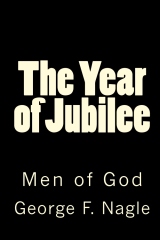
Harrisburg on the eve of Civil War
Study Areas
Operations of Slave Trader
Hope Hull Slatter
Early Operations in the Carolinas
1831: Fayetteville, North Carolina.
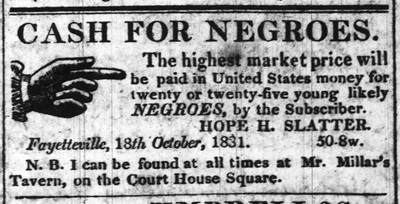
CASH FOR NEGROES.
The highest market price will be paid in United States money for twenty or twenty-five young likely NEGROES, by the Subscriber.
HOPE H. SLATTER.
Fayetteville, 18th October, 1831.
N.B. I can be found at all times at Mr. Millar's Tavern, on the Court House Square.
Source: Fayetteville (NC) Weekly Observer, 19 October 1831
1833: Wilmington, North Carolina.
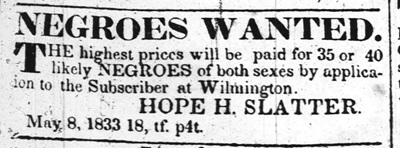
NEGROES WANTED.
THE highest prices will be paid for 35 or 40 likley NEGROES of both sexes by application to the Subscriber at Wilmington.
HOPE H. SLATTER.
May 8, 1833
Source: The People's Press and Wilmington (NC) Advertiser, 3 July 1833
1833: Hamburg, South Carolina.
In 1833 Hope Hull Slatter partnered with his younger brother Shadrack Fluellen Slatter to sell enslaved persons in Hamburg, South Carolina. The Hamburg slave market was established to work around the laws prohibiting the importation of slaves into Georgia, just across the Savannah River. Georgia planters wishing to purchase imported slaves could simply cross the river into Hamburg from Augusta and purchase as many slaves as needed. The two advertisements below are from the Georgia Telegraph, published in Macon. These very public advertisements show the widespread acceptance and support by planters and the general population in Georgia of this practice.
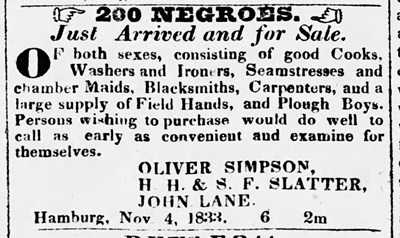
(Georgia Telegraph, 14 November 1833)
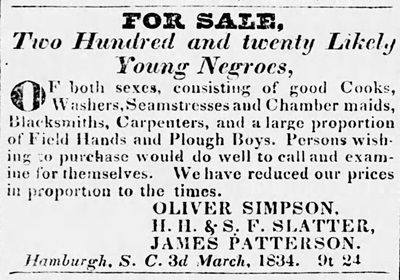
Georgia Telegraph, 25 April 1834. Note the last line "We have reduced our prices in proportion to the times." Since the demand for cotton and slaves rose between 1834 and 1836, this announcement perhaps points to an increase of slave traders into Hamburg attracted by this lucrative practice.
1834: Charleston, South Carolina.
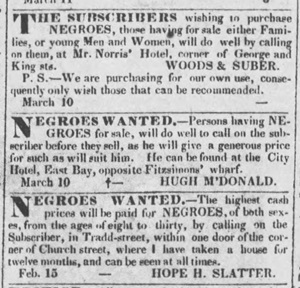
NEGROES WANTED.
The highest cash prices will be paid for NEGROES, of both sexes, from the ages of eight to thirty, by calling on the Subscriber, in Tradd-street, within one door of the corner of Church street, where I have taken a house for twelve months, and can be seen at all times.
Feb. 15 -- HOPE H. SLATTER.
Source: Charleston (SC) Courier, 12 March 1834
Notes: Slatter (bottom ad) was one of three businessmen advertising for enslaved Black persons in Charleston, a busy slave-trade center. Hugh and Alexander McDonald were longtime Charleston slave merchants. Slatter took up residence for a year in this competitive market in order to develop his slave business. Slaves purchased from here could be easily transported to his brother Shadrack in Hamburg.
The Baltimore Operation
About 1835 Hope Hull Slatter and Shadrack Fluellen Slatter developed the business model that would bring incredible wealth to each of them even as it created hardship, emotional turmoil and death for thousands of enslaved persons in the mid-Atlantic and Chesapeake region. Hope Hull Slatter established himself in Baltiimore as early as 1835, advertising to purchase locally enslaved persons whom he transported to his brother Shadrack Fluellen Slatter in New Orleans (Republican & Commercial Advertiser, 2 February 1835, cited in "Baltimore's Old Slave Markets," by Stanton Tierney, Baltimore Sun, 13 September 1936).
Envisioning the potential of this highly profitable operation, Hope Hull Slatter built a large prison on Pratt Street, which he touted as an "ediface," constructed on "the most approved principle, with an eye to comfort" for the enslaved persons held within:

CASH FOR NEGROES.
Slatter's business was highly successful. In 1841 he expanded his establishment with the purchase of a large neighboring tract:
The subscriber has built a large and extensive establishment and private jail, for the keeping of SLAVES, in PRATT-ST., one door from Howard-st. opposite the Circus or Repository.
The building having been erected under his own inspection, without regard to price; planned and arranged upon the most approved principle, with an eye to comfort and convenience, not surpassed by any establishment of the kind in the United States, is now ready to receive SLAVES. The male and female apartments are completely separate -- the rooms for both are large, light and airy, and all above ground, with a fine large yard for exercise, with pure delightful water within doors.
In erecting and planning this edifice, the subscriber had an eye to the health and cleanliness of the slaves, as well as the many other necessary conveniences. Having a wish to accommodate my Southern friends and others in the trade, I am determined to keep them on the lowest possible terms, at twenty-five cents per head a day, and furnish them with plenty of good and wholesome provisions.
Such security and confidence I have in my building, that I hold myself bound to make good all jail breaking, or escapes from my establishment. I also will receive, ship, or forward to any place, at the request of the owner, and give it my personal attention.
N.B. -- Cash and the highest prices will at all times be given for likely slaves of both sexes, with good and sufficient titles. Persons having such property to dispose of, would do well to see me before they sell, as I am always purchasing for the New Orleans market -- I or my agent can at all times be found at my office, in the basement story of my new building.
HOPE H. SLATTER.The "Repository." -- Messrs. Lemmon & Co sold at auction, a lot of ground fronting one hundred and twenty feet on the south side of Pratt street, with a brick building thereon known as the "Repository," and at one time occupied as a circus, for $14,400. It was purchased by Hope H. Slatter. (The Baltimore Sun, 13 November 1841)
The enslaved persons purchased by Slatter in Baltimore from the surrounding farms and towns were transported by sea to his brother Shadrack in New Orleans. Shadrack had established himself on the Esplanade in that city, advertising:

(The Times Picayune (New Orleans), 25 November 1842)

(The Times Picayune (New Orleans), 19 December 1843)
Slatter's success in only a few years in Baltimore is shown by the price he paid for the Repository, a value that in US dollars equates to over $500,000 today. (https://www.officialdata.org/us/inflation/1841). His business continued to prosper over the next few years. His standard advertisement through 1845 was brief and emphasized his continued willingness to purchase enslaved people:
NEGROES WANTED. -- Having returned from New Orleans, I will now pay the highest cash prices for all likely NEGROES that are slaves for life and good titles. All communications will be promptly attended to.At his height, he was regularly shipping enslaved persons by the dozens to New Orleans. The images below are of a Baltimore manifest for the ship Scotia, shipping enslaved persons owned by Slatter to New Orleans in September 1843:
HOPE H. SLATTER, Pratt street, Baltimore.
N.B. -- On the 7th day of June, 1844, Jonathan M. Wilson, (my former Agent) by mutual consent, withdrew from my employment, and is no longer my agent.
(The Baltimore Sun, 25 September 1844)

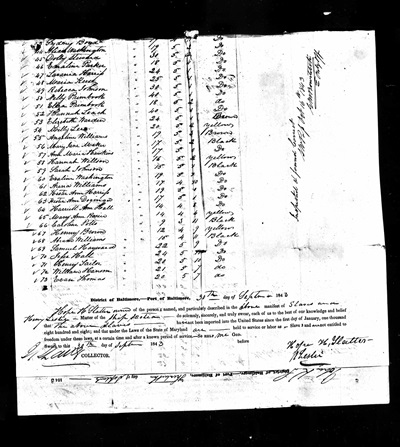
The image below is of a Baltimore manifest for the barque Hermitage, shipping enslaved persons owned by Slatter to New Orleans in October 1846:
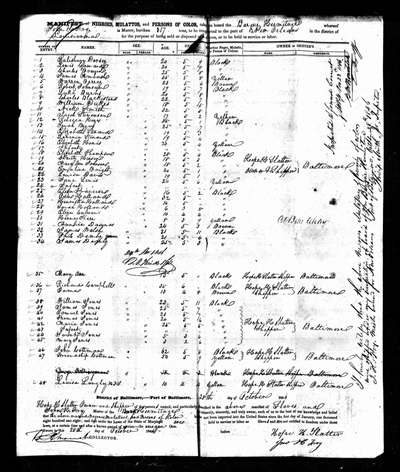
The names of all the enslaved persons on the September 1843 voyage of the ship Scotia are transcribed here.
The names of all the enslaved persons on the October 1846 voyage of the barque Hermitage are transcribed here.
Helping in the family business was Henry F. Slatter, son of Hope Hull and his first wife, Mary. Henry worked in New Orleans with his uncle Shadrack, as seen in this advertisement from 1845:

Slatter's advertisement directs sugar planters to examine the newly-arrived slaves. Sugar cane plantations were particularly dreaded final destinations for thousands of enslaved men, women and children from Maryland and Virginia due to the extremely brutal working conditions and high death rate of the enslaved workers. Sugar cane harvesting and processing was the most dangerous agricultural work in the country and the cane fields of Louisiana were owned and managed by many of the same sugar cane planters who had fled the violence and slave uprisings in the Carribbean. It was not uncommon for overworked and underfed workers to drop dead after seven years. (The Times Picayne, 03 October 1845; "The sugar that saturates the American diet has a barbaric history as the 'white gold' that fueled slavery," Khalil Gibran Muhammad, New York Times Magazine, 14 August 2019, published by The 1619 Project, https://www.nytimes.com/interactive/2019/08/14/magazine/sugar-slave-trade-slavery.html, accessed 17 November 2023)
Selling Out to the Campbell Brothers
In 1847, Hope Hull Slatter either left or prepared to leave the slave trading business. An advertisement placed by his son Henry in The Baltimore Sun in 1847 refers to "the old establishment of SLATTER'S." Even as Hope Hull Slatter was leaving the business, demand for enslaved people from Maryland to feed the increasing demand in the deep South was extremely strong, as can be seen from the ad seeking to buy 500 enslaved persons for shipment south. This ad ran regularly in the major Baltimore papers for six months:
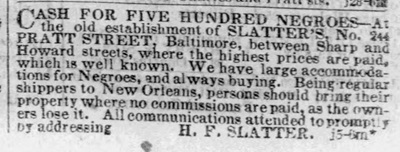
(The Baltimore Sun, 11 March 1847)
Henry would not continue in the family business, however. In 1848 he moved to Montgomery, Alabama where took up the hotel business, but he lived only another year, dying there at age 32 of "consumption," the 19th century term for tuberculosis, in 1849.
By that time, both Hope Hull Slatter and his brother Shadrack had accumulated incredible personal fortunes and sold their business to the brothers Walter L. and Bernard M. Campbell, competing slave traders based in Baltimore. Hope Hull Slatter "retired" to Mobile, Alabama, where he died in a Yellow Fever outbreak in 1853.
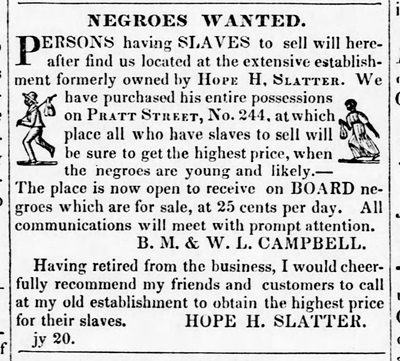
(Port Tobacco and Charles County Advertiser, 27 July 1848)

(The Times Picayune, New Orleans, 31 January 1849)
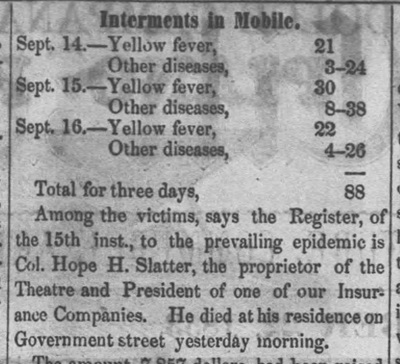
(The Autauga Citizen, Prattville, Alabama, 22 September 1853)
The Year of Jubilee
Vol. 1: Men of God and Vol. 2: Men of Muscle
by George F. Nagle
Both volumes of the Afrolumens book are now available to read directly from this site.


